Are Job's Behemoth and Leviathan dinosaurs or mythical beings? Uncover the mystery that bridges biblical texts and paleontology, leaving more questions than answers.
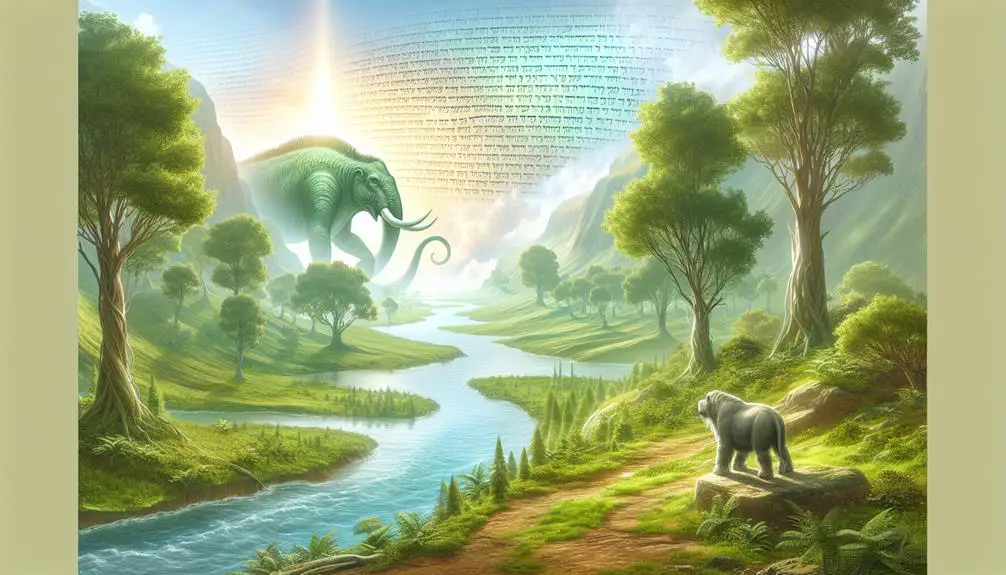
Dinosaurs in the Bible Verse Job
Opening Pandora's box on the topic of dinosaurs in the Bible, especially within the verse of Job, you're stepping into a realm where history, faith, and science intersect intriguingly.
The descriptions of Behemoth and Leviathan have tantalized scholars and enthusiasts alike, suggesting a bridge between biblical texts and paleontological evidence.
As you explore Job's ancient words, you'll find yourself questioning whether these creatures could be the dinosaurs we know today or symbols of something far deeper.
This journey might not only reshape your understanding of ancient texts but also challenge the boundaries of modern faith.
Let's venture into this uncharted territory together, shall we?
Key Takeaways
- Job's descriptions of Behemoth and Leviathan align with characteristics of ancient reptiles, hinting at dinosaur-like creatures.
- The text bridges past and present, connecting biblical accounts with scientific findings on prehistoric life.
- Artistic and scholarly interpretations evolve, reflecting the awe-inspiring nature of these creatures as symbols of divine power.
- Understanding Job within its historical and cultural context enriches modern faith discussions on science and scripture.
The Mystery of Behemoth
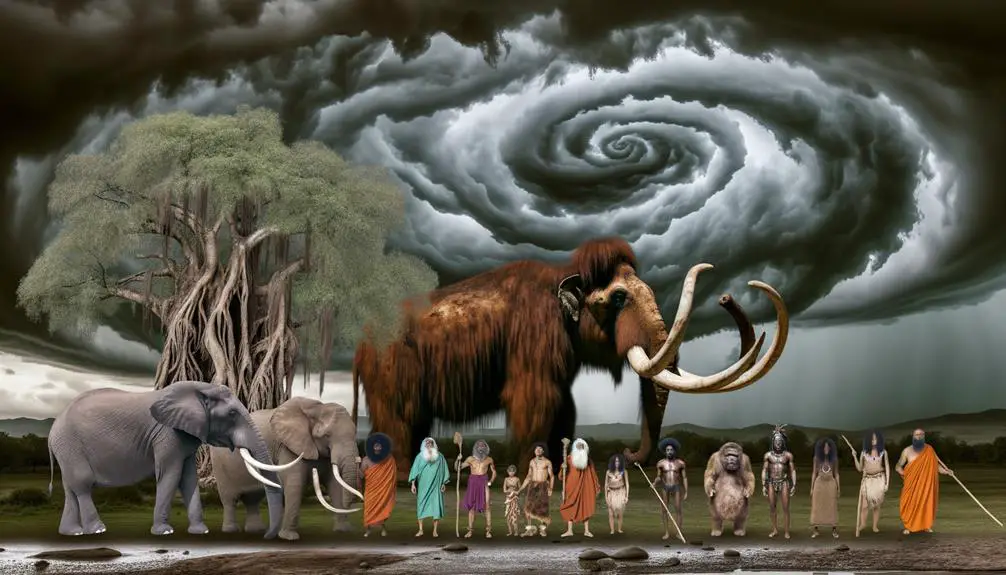
In analyzing the enigmatic figure of Behemoth mentioned in the Book of Job, it's crucial to scrutinize the text for insights into its possible identity and significance within a biblical context. The behemoth origins are shrouded in mystery, compelling scholars and theologians alike to embark on a quest for understanding this creature's place in the tapestry of biblical narratives. This pursuit not only deepens one's comprehension of ancient texts but also enriches the dialogue on how mythical entities are integrated into religious lore.
Artistic depictions of Behemoth throughout history have varied widely, reflecting the evolving interpretations of its nature. Initially, these representations were likely influenced by the limited understanding of the natural world, leaning towards fantastical and often exaggerated portrayals. As knowledge expanded, so did the portrayal of Behemoth, with some artists and scholars suggesting that it might symbolize primeval forces of chaos and creation, inherent in the world's formation according to biblical accounts. This shift in perception underscores the fluidity with which ancient texts can be interpreted, highlighting the intersection between faith, folklore, and the quest for scientific understanding.
The behemoth's origins, therefore, aren't just a matter of identifying a specific creature but understanding the broader cultural and theological implications of its inclusion in the Bible. Its portrayal, both in text and art, serves as a mirror reflecting humanity's evolving relationship with the natural world and the divine. By delving into this mystery, you're not just exploring a biblical enigma but also engaging with a rich tradition of theological and artistic inquiry that spans centuries.
Leviathan: A Biblical Beast
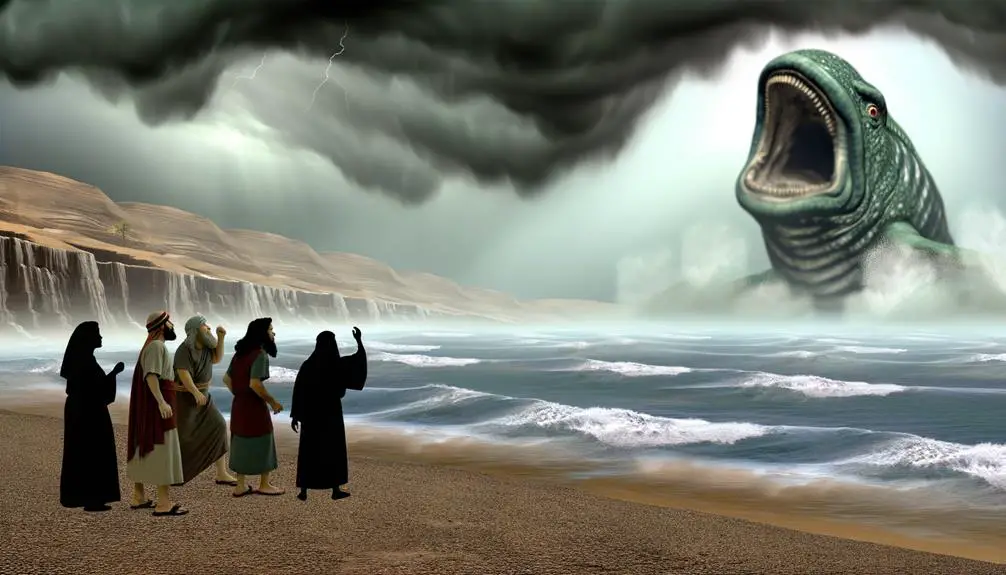
Turning your attention to Leviathan, you encounter a creature enveloped in both mystery and majesty within the biblical text of Job.
Leviathan's description not only captivates with its vivid imagery but also invites an exploration into its symbolic significance across various interpretations.
This analysis prompts you to consider how Leviathan transcends its literal depiction, embodying themes of chaos, power, and divine authority.
Leviathan's Description Detailed
Leviathan's depiction in the Book of Job showcases a formidable, serpentine creature, embodying chaos and divine power within ancient biblical texts. This image has intrigued scholars and believers alike, stirring debates over its real-world origins.
You'll find that Leviathan's characteristics align closely with those of marine reptiles, suggesting possible inspiration from prehistoric creatures known to ancient peoples through fossil records. Artistic depictions often portray Leviathan as a monstrous sea dragon, a confluence of the natural and supernatural, blending the known with the mythical.
These representations serve not only as a testament to the creature's feared status but also highlight the ancient world's fascination with and reverence for the mysteries of the deep. Through Leviathan, the Bible encapsulates the awe-inspiring power of creation, bridging the gap between historical creatures and theological symbolism.
Symbolism of Leviathan
Delving into the symbolism of Leviathan reveals a multifaceted representation of chaos and divine power that resonates deeply within the biblical narrative. This sea monster, entrenched in maritime myths, serves as a powerful chaos symbol, embodying the untamable and formidable forces of nature that only a divine entity can control. Its portrayal offers insight into ancient perceptions of the cosmos, where the sea represented the unknown and the fearsome.
- Leviathan as an embodiment of chaos and disorder.
- A metaphor for the power and authority of the divine over creation.
- Reflects ancient maritime myths, emphasizing the sea's mystery and danger.
- Serves as a reminder of humanity's vulnerability and the necessity of divine protection.
This analysis uncovers the profound layers of meaning behind Leviathan, enriching our understanding of its role in biblical literature.
Job's Ancient Descriptions
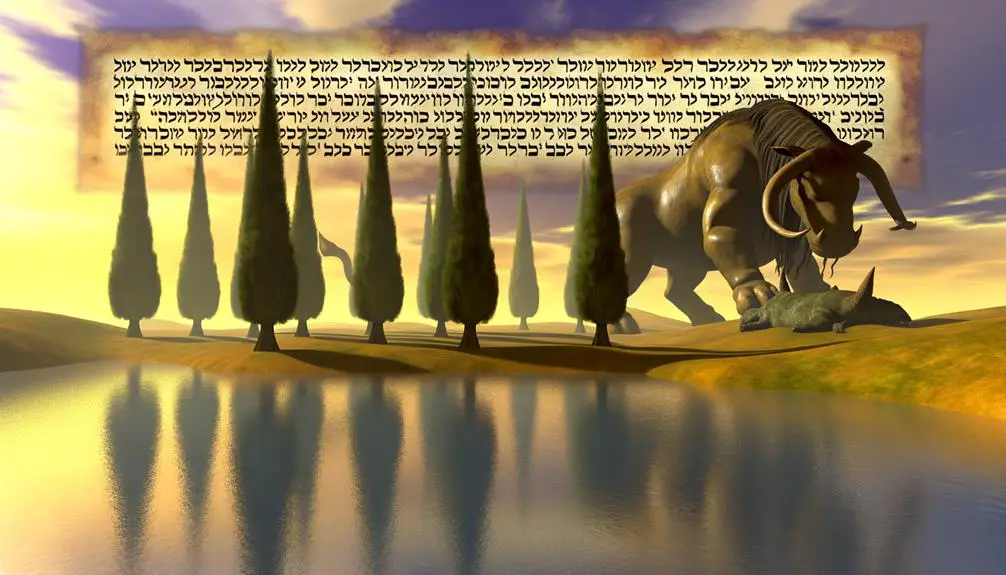
In analyzing Job's ancient descriptions, one finds a compelling depiction of creatures that challenge modern interpretations of biblical zoology. The text intricately describes entities that, at first glance, might seem mythical or out of place in the natural history as we understand it. However, a deeper examination reveals layers of possible truth intertwined with the narrative.
You'll notice that Job's account, rich in detail and imagery, doesn't exist in isolation. Geological evidence supports the notion that the creatures mentioned could have roamed the Earth. Fossil records, albeit incomplete, provide a tangible link to the descriptions found within the verses. These ancient remains tell a story of a world vastly different from today, a world where creatures described in Job mightn't just be plausible but probable.
Moreover, artistic depictions from various ancient cultures seem to echo Job's descriptions. These artworks, found across different continents, portray creatures remarkably similar to those in Job. This congruency between Job's accounts and ancient art suggests not only a shared knowledge of such creatures but also a widespread awe and reverence for them.
This analytical journey through Job's ancient descriptions, supported by geological evidence and corroborated by artistic depictions, invites a reevaluation of biblical creatures. It challenges the reader to consider the possibility that these descriptions aren't merely symbolic or mythological but could be rooted in historical reality. The text, therefore, acts as a bridge connecting the past with the present, offering insights into the rich tapestry of Earth's history as recorded through both scripture and science.
Comparing Creatures to Dinosaurs
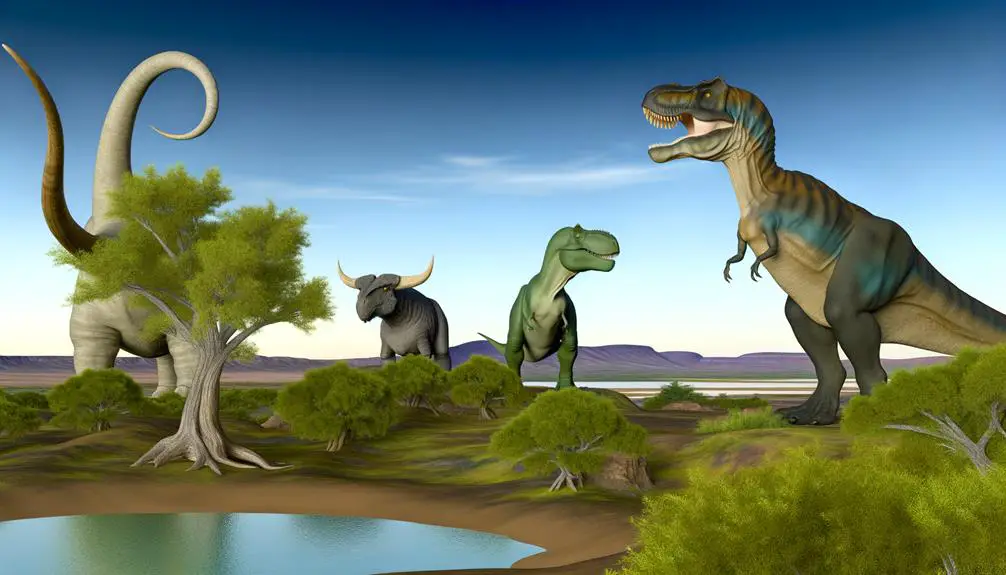
Upon examining the descriptions found in Job, it's compelling to note how closely these ancient creatures resemble what we now understand as dinosaurs. The vivid imagery and detailed accounts prompt an analytical dive into the prehistoric parallels that can be drawn between these biblical descriptions and the fossil evidence we've unearthed over centuries.
When you scrutinize the characteristics and behaviors of these creatures as described in Job, several intriguing comparisons emerge:
- Size and Strength: The sheer magnitude and formidable nature of these beings echo the colossal dinosaurs, whose skeletal remains have astounded scientists.
- Habitat and Lifestyle: Descriptions that hint at their dwelling in untamed, marshy, or riverine environments align with paleoecological findings regarding certain dinosaurs' preferred habitats.
- Anatomical Features: Specific references to formidable teeth, massive tails, and impenetrable scales mirror the physical attributes of creatures like the Tyrannosaurus Rex, Stegosaurus, and Ankylosaurus.
- Mystique and Majesty: The awe and reverence with which these creatures are described resonate with the fascination and veneration that dinosaurs evoke in modern science and popular culture.
This scholarly comparison isn't about proving dinosaurs' explicit mention in ancient texts but rather appreciating the potential overlap in descriptions. The convergence of fossil evidence and ancient literature enhances our understanding of the past, bridging the gap between science and scripture. It's a testament to the richness of human curiosity and our never-ending quest to make sense of the world around us, drawing connections across time and disciplines.
The Historical Context
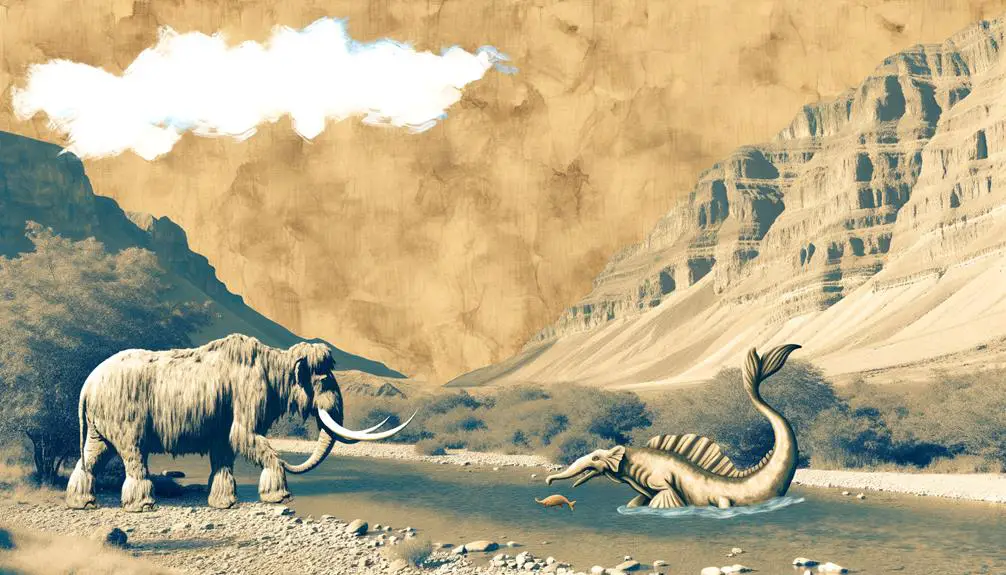
To truly grasp the significance of the dinosaurs mentioned in the Book of Job, you must first understand the historical backdrop against which this text was written.
The interpretation of ancient texts, particularly the timeframe of Job's life, and the cultural beliefs of that era offer invaluable insights.
These components collectively shed light on how contemporaries of the scripture might've perceived these colossal creatures, leading to a more nuanced comprehension of biblical references.
Ancient Text Interpretation
Delving into the historical context, you'll discover that interpreting ancient texts, such as the mention of 'dinosaurs' in the Book of Job, requires a nuanced understanding of the era's literary and cultural landscape. Achieving scriptural accuracy while uncovering metaphorical meanings demands a comprehensive approach:
- Consideration of the original language and its possible translations.
- Analysis of the socio-political environment at the time of writing.
- Exploration of contemporary literary forms and genres.
- Identification of symbolic and allegorical elements within the text.
This method allows for an insightful interpretation, bridging the gap between ancient narratives and modern comprehension. It's essential to view these texts through a lens that appreciates both their historical significance and their evolving interpretations over time.
Job's Time Period
Understanding the historical context of Job's time period requires a deep dive into an era shrouded in antiquity.
Here, oral traditions and early literary efforts began shaping the cultural and religious narratives of ancient societies.
You'll find that geological dating and archaeological evidence play crucial roles in piecing together this puzzle.
These tools offer a window into the world that framed the Book of Job, suggesting a backdrop that's as complex as the narrative itself.
By examining sediment layers and uncovering artifacts, scholars can approximate the era in which Job might've lived, providing context to the biblical account.
This analytical approach enables you to grasp the significance of Job's story within its historical setting, avoiding anachronisms and understanding the text in a way that's both informed and insightful.
Cultural Beliefs Compared
Having established the timeline of Job's era through geological and archaeological evidence, we'll now compare the cultural beliefs of that period to gain a clearer understanding of the narrative's deeper layers.
- Mythological Interpretations: The era's rich tapestry of myths offers insights into how ancient societies conceptualized beings akin to what we might identify as dinosaurs today.
- Global Traditions: Across various cultures, there existed strikingly similar tales of giant creatures, suggesting a shared memory or interpretation of prehistoric life.
- Sacred Texts: Many ancient texts, including the Bible, weave stories that can be seen as allegorical references to such creatures.
- Artistic Depictions: Archaeological findings include art that hints at humanity's long-standing fascination with large, reptilian creatures, bridging the gap between myth and possible reality.
This comparative analysis reveals the interconnectedness of myth, tradition, and empirical evidence in shaping our understanding of the past.
Implications for Modern Faith
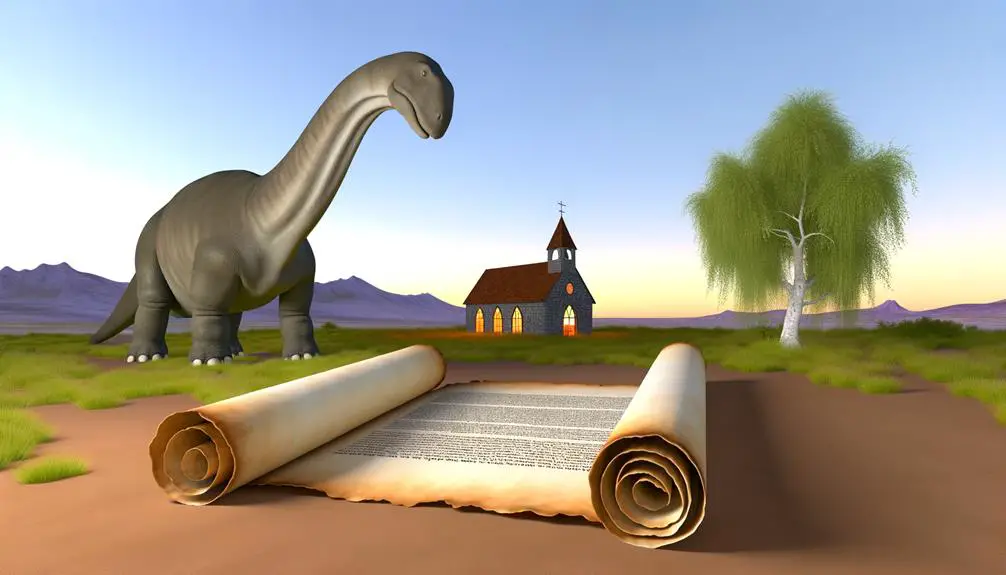
Interpreting references to creatures that could be dinosaurs in the Book of Job poses intriguing questions about their significance for contemporary faith. This dialogue sits at the intersection of faith questions and scientific debate, challenging you to explore how ancient texts interact with modern understandings of history and science.
Aspect |
Implication for Modern Faith |
|---|---|
Historical Context |
Offers a lens to interpret scriptures in light of scientific discoveries. |
Faith and Science |
Encourages a nuanced view that embraces both faith and empirical evidence. |
Theological Meaning |
Invites deeper exploration of the nature of God's creation. |
Faith Application |
Encourages believers to engage with their faith intellectually, not just spiritually. |
This exploration requires you to consider the broader implications of integrating scientific discoveries with biblical interpretations. The presence of dinosaur-like creatures in Job doesn't weaken your faith; rather, it enriches your understanding of the divine tapestry of creation.
By engaging with both the spiritual and the empirical, you're invited to deepen your relationship with faith. This doesn't mean choosing between science and religion but understanding that both can coexist, each offering valuable insights into the world around us and our place within it.
Thus, the journey through Job and its ancient creatures isn't just about reconciling faith with science—it's about expanding your spiritual horizon to embrace a more comprehensive view of the divine. This, in turn, fosters a faith that's both intellectually robust and deeply spiritual.
Frequently Asked Questions
How Have Different Religious Denominations Interpreted the Descriptions of Behemoth and Leviathan Within Their Theological Frameworks?
You've likely noticed that different religious groups interpret behemoth and leviathan with varying lenses. Modern interpretations dive deep into creationist debates, analyzing these creatures beyond mere biblical symbols.
Some see them as literal ancient beings, bolstering young-earth creationist views, while others suggest they're metaphorical, embodying chaos and power in spiritual narratives. This spectrum of understanding showcases the dynamic engagement with sacred texts, reflecting broader theological and existential inquiries within faith communities.
Are There Any Ancient Texts or Civilizations Outside of the Bible That Mention Creatures Resembling Behemoth and Leviathan, Suggesting a Cross-Cultural Phenomenon?
Yes, ancient texts and civilizations beyond the Bible mention creatures akin to behemoth and leviathan, hinting at a cross-cultural phenomenon. These tales blend mythological symbolism and cultural amalgamation, weaving together narratives that transcend individual societies.
From Mesopotamian epics to Hindu scriptures, you'll find echoes of these behemoths, suggesting a shared human fascination with the monstrous. This insight underscores the power of myth to bridge disparate cultures, revealing a common thread of awe and wonder.
How Do Paleontologists and Scientists Specializing in the Study of Dinosaurs Respond to the Interpretations of Behemoth and Leviathan as Possibly Being Dinosaurs?
You might find that paleontologists and dinosaur experts generally don't support the idea that behemoth and leviathan are dinosaurs. They rely on geological timelines and dinosaur fossils that indicate these creatures went extinct long before humans appeared.
Extinction theories, based on scientific evidence, further distance dinosaurs from the biblical creatures. These experts analyze fossils and historical data, leading to a consensus that doesn't align with the interpretation of dinosaurs in biblical contexts.
What Role Do Linguistic Analyses and Ancient Hebrew Language Studies Play in Understanding the True Nature of the Creatures Described in the Book of Job?
You're diving into how linguistic analyses and ancient Hebrew studies clarify the nature of mythical creatures. By tackling semantic ambiguity and translation challenges, you unlock deeper meanings lost over time.
This approach isn't just about words; it's a quest to grasp the true essence of ancient texts. Your journey through syntax and semantics offers a scholarly, insightful look into how language shapes our understanding of history's mysteries.
It's where analysis meets ancient wisdom.
How Have Depictions of Behemoth and Leviathan in Art and Literature Evolved Over the Centuries, Reflecting Changing Interpretations and Understandings of These Biblical Creatures?
You've seen how artistic depictions and literary portrayals of behemoth and leviathan have morphed throughout time, embodying the shifting sands of interpretation.
Modern interpretations are rich with artistic symbolism, reflecting our evolving grasp of these enigmatic figures.
This evolution in portrayal showcases the dynamic nature of how we understand ancient texts, revealing a fascinating interplay between traditional beliefs and contemporary insights, all while navigating through the murky waters of historical and religious scholarship.
Conclusion
In scrutinizing the scriptures, you've ventured through verdant valleys of verse, encountering the enigmatic entities of Behemoth and Leviathan. These ancient accounts, artistically articulated in Job, juxtapose Jurassic juggernauts, suggesting a semblance with dinosaurs.
This textual tapestry, woven within a historical context, challenges contemporary conceptions, compelling a critical contemplation of faith and fossils. Thus, your journey juxtaposes the jurassic with the sacred, enriching your understanding of biblical beasts and bridging beliefs with the bones of bygone behemoths.



Sign up